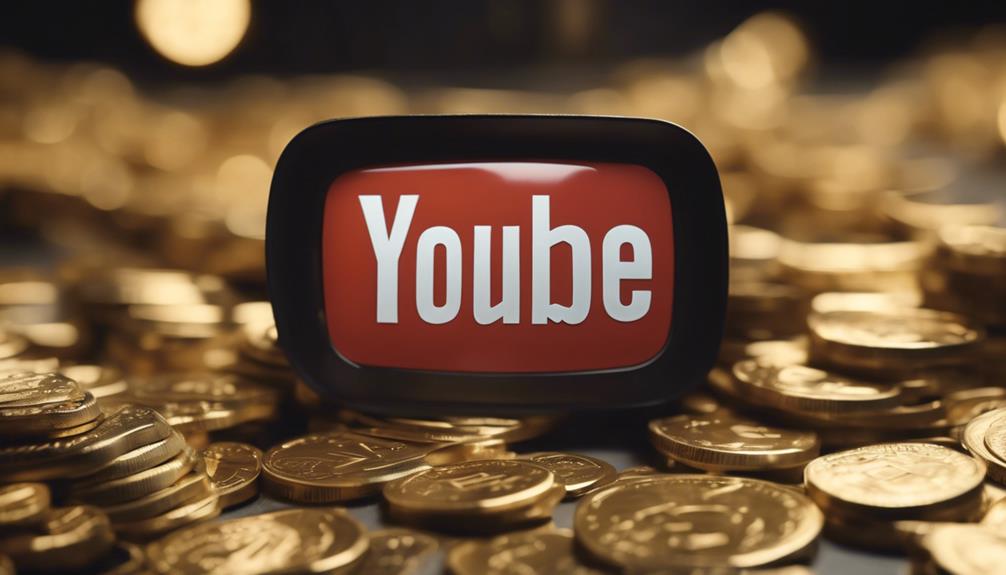
How much money is 1 billion views on YouTube?
Is the theory that 1 billion views on YouTube equates to a million-dollar payday really accurate?
You’ve likely heard the stories of viral YouTube sensations raking in a fortune from their popular videos. But before you quit your day job and start uploading, it’s crucial to grasp the complexities of YouTube’s monetization system. Factors such as ad rates, viewer location, and video length all play a vital role in your potential earnings.
Intrigued? Let’s unravel these factors to better understand the potential worth of a billion views.
Key Takeaways
- Earnings from 1 billion views vary due to factors like viewer interaction, ad formats, and advertiser demographics.
- High-view videos like ‘Despacito’ and ‘Baby Shark Dance’ show the financial potential of universal appeal.
- Profits can be maximized by optimizing search visibility, audience engagement, and diversifying income streams.
- Understanding the dynamics of ad revenue and matching content with high-paying niches can significantly influence earnings.
Understanding YouTube’s Monetization System

To truly grasp the potential earnings from 1 billion YouTube views, you must first understand YouTube’s complex monetization system. It’s not as simple as getting views. The ad revenue dynamics play a crucial role in determining your earnings. Advertisers pay YouTube to display their ads, and in turn, YouTube shares a portion of this revenue with you, the content creator.
Now, the Creator Academy insights suggest that the type of ad, the pricing of the ad, and even the location of the viewer can influence your earnings. For instance, you’ll earn more when viewers interact with an ad or watch it for at least 30 seconds. Moreover, ads that are in high demand (like those during the holiday season) can boost your earnings.
Key Factors Influencing Earnings
Understanding these ad revenue dynamics is vital, but it’s also essential to know that other key factors can significantly influence your earnings from YouTube.
Advertiser demographics play a crucial role. Advertisers target their ads to specific audiences, and if that audience aligns with your content, you’re in a better position to earn. For instance, if your content resonates with a demographic that has high purchasing power, advertisers are likely to spend more on your videos.
Video length is another critical determinant. Longer videos allow for more ad placements, which can boost your revenue. However, it’s a balancing act. You need to create engaging content that keeps viewers hooked for longer periods, but you also don’t want to stretch your videos unnecessarily.
Remember, YouTube’s algorithms favor engagement, not just views. Therefore, it’s not about creating long videos for the sake of it, but about delivering value. A longer video with high engagement could potentially earn more than a shorter one with the same number of views.
In essence, understanding your audience, tailoring your content to match advertiser demographics, and optimizing video length can significantly affect your earning potential on YouTube.
Estimated Earnings Per View

Now, let’s delve into the heart of the matter: how much does YouTube actually pay per view? It’s not a straightforward answer as earnings depend on various factors.
- Viewer Engagement Impact: If users watch ads for at least 30 seconds, you earn more. Clicks on ads also boost revenue.
- Ad Blocker Consequences: The use of ad blockers reduces potential earnings, as ads aren’t viewed.
- Type of Ad: Different ad formats have varying payouts. Skippable video ads pay more than display ads.
- Viewer’s Location: Ads in some countries pay higher rates.
- Content Type: Advertisers pay more for certain niches, such as finance or technology.
On average, you can expect to earn between $0.01 and $0.03 per view with AdSense. But remember, YouTube takes a 45% cut. So, for 1 billion views, you’re looking at roughly $550,000 to $1.5 million, before any deductions for production costs or taxes.
This is a ballpark figure. Variations in the factors above can greatly impact your final earnings. So, there’s potential for more, but also for less. It’s a game of strategy and constant optimization.
Case Study: Billion-View Videos
Let’s examine some real-life examples of videos that have surpassed the billion-view mark on YouTube. A viral trends analysis reveals a wide range of content that can achieve this feat. From music videos to kids’ content, the possibilities are vast.
Take ‘Despacito’ by Luis Fonsi, for instance. This music video didn’t just hit a billion views; it blasted past 7 billion, demonstrating the immense power of the celebrity influence study. Fonsi’s unique blend of Latin rhythms and catchy pop melodies resonated with a global audience, making his video a viral sensation.
Then there’s ‘Baby Shark Dance’ by Pinkfong. This children’s song, with its catchy tune and simple dance moves, racked up over 10 billion views. The video’s success can largely be attributed to its mass appeal to kids worldwide and the trend of sharing it among parents.
These examples show that achieving a billion views on YouTube isn’t confined to a specific genre or demographic. It’s about creating content that resonates with a broad audience, whether through catchy music, relatable themes, or universal appeal. Understanding these trends can guide creators in crafting innovative, viewer-centric content.
Maximizing Profit as a YouTuber

To maximize your profit as a YouTuber, it’s crucial to focus not only on the number of views but also on effective monetization strategies. You need to understand how YouTube’s monetization model works and how you can leverage it to your benefit.
Brand strategies are vital for creating a unique and recognizable identity that distinguishes your channel from others. A strong brand can help attract sponsors and partnerships, increasing your revenue.
Video optimization enhances your visibility. Use SEO-friendly titles, descriptions, and tags to help your videos rank better in YouTube’s search results.
Engaging with your audience increases viewer retention. Responding to comments and creating community posts encourages viewers to return to your channel.
Diversifying your income streams can reduce reliance on ad revenue. Consider merchandise sales, fan funding, or offering premium content through memberships.
Regularly analyzing your performance using YouTube analytics can guide your content strategy. It helps identify what works and what doesn’t, enabling you to adjust your approach.

